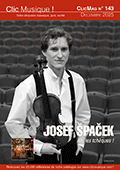 Celui que l’on qualifiait de « Beethoven français », admiré à l’étranger, que Berlioz considérait comme « une des plus belles gloires musicales de la France », fut pourtant rapidement oublié après sa mort. Une grande partie de son œuvre est consacrée à la musique de chambre. Déjà sortis précédemment chez Brilliant Classics, ces quintettes avec piano sont ici regroupés nous permettant ainsi d’apprécier pleinement le style brillant du compositeur. Le Nepomuk Fortepiano Quintet s’est fait une spécialité des quintettes avec piano composés entre 1799 et 1882 dans la formation violon, alto, violoncelle, contrebasse et piano. Il interprète à merveille ces quintettes d’Onslow y apportant le souffle lyrique et romantique nécessaire. L’opus 70 (1846) accorde une importance particulière à l’écriture pianistique aux passages à la technique exigeante en faisant une œuvre enthousiasmante, quasi-concertante, à l’écriture variée et aux contrastes passionnés. L’opus 76 (1847) est un arrangement de la quatrième et dernière symphonie d’Onslow. L’écriture semble effectivement plus orchestrale. Le piano y est toujours flamboyant au sein d’un discours dynamique alternant effets dramatiques et charme délicat de la mélodie. À l’écoute de ces œuvres qualitatives, on se dit que la postérité a été bien injuste envers George Onslow ! (Laurent Mineau)  Hailing from an aristocratic English family, George Onslow (1784-1853) grew up as a nobleman in Clermont-Ferrand, France. From the 1830s onwards, Onslow appeared frequently in Parisian musical circles. At this time, opéra comique was the favoured musical genre. Composers such as Meyerbeer, Rossini, and Donizetti were popular, alongside the dazzling Romantic piano music of Liszt and Chopin. Onslow’s strict classical style, however, made him unique in Paris at that time, earning him the nickname, ‘French Beethoven’. Onslow concentrated primarily on instrumental chamber music; his opus includes 36 string quartets, 34 quintets and 3 piano quintets. The Piano Quintet Op.76, written in 1846, is an arrangement of his 4th Symphony. An interesting feature of this work is the nickname of the Finale, ‘Le Coup de Vent’. Although not mentioned by Onslow himself, this movement is suggestive of the Aeolian harp, an instrument popular in the 19th century. When placed by an open window, this instrument, consisting of strings in a box, would vibrate in the wind, producing an ethereal sound. Onslow might have been imitating this effect in the Finale with his use of rapid chromatic scales and a glass-like tinkling that can only be achieved with a special pedal effect available on some instruments of that period. A piano quintet can be composed for different combinations of instruments: violin, viola and two cellos, or, as was often the case in the second half of the 19th century, two violins, viola and one cello. The combination including double bass that the Nepomuk Fortepiano Quintet employs was used mainly in the first half of the 19th century. George Onslow composed a number of quintets with two cellos. At one performance one of the cellists did not arrive and so the virtuoso double bassist Domenico Dragonetti, who was by chance present, suggested that he replace the absent cellist. The composer resisted at first, be unpleasant, but the performance was such fearing that the resulting sound colour would a great success that he was immediately convinced. After his death in 1853, Onslow’s fame faded rapidly, and his works fell out of favour. Fortunately, there has been an increase in interest in his works in recent times, and his compositions can be heard frequently in concert halls today.
 |
